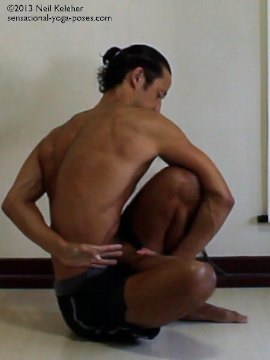Marichyasana D
Making the Impossible Merely Difficult, Tips for Working Towards Binding
Marichyasana D is a twisting yoga pose that has one let in lotus, the other leg in the marichyasana position. Meanwhile you twist towards your marichyasana leg and bind it while grabbing one wrist behind your back.
I've only been able to succesfully bind in this pose a few times. Below is what I do to make getting into it as easy as possible. Suggested warm ups can include half bound lotus forward bend, marichyasana b with an open twist (towards the lotus leg side), marichyasana b (bending forwards).
Warm up with a Twist
So that Marichyasana D is as easy as possible, I'd suggest warming up with a twist. In whatever twist you do, focus on turning your ribs relative to each other and relative to your pelvis.
You can also focus on feeling your thoracic vertebrae turning relative to each other. (The thoracic vertebrae are the vertebrae to which the ribs attach.)
While twisting, you can think of your ribs as levers that you can use to turn your thoracic vertebrae relative to each other and relative to your pelvis.
Clamp Your Foot with the Marichyasana Leg
Doing the side where the left foot is in lotus, then your right foot will be in the marichyasana position. (Knee bent, foot on the floor, knee pointing upwards.)
Use your marichyasana leg to to pinch or clamp your lotus foot in position.
You can then relax the knee and hip of your lotus leg.
To clamp your lotus foot, focus on moving the top of your pelvis towards your marichyasana thigh. Use the hip muscles on the side of your marichyasana leg, not the lotus side hip. Grip the foot between your belly and your thigh. Relax the hip your lotus leg.
Positioning Your Lotus
Prior to clamping your foot you can position your lotus leg foot so that the heel presses into your lower belly while the center of the top of your foot is over the center line of your thigh.
When doing a posture like half bound lotus, the back of your non lotus leg stays on the floor. You pelvis tilts towards your leg and it is then easier for your lotus leg knee to touch the floor. In Marichyasana D, you stay upright. Actually, you move your foot to your belly when you bend the knee of your marichyasana leg. And so it makes sense to lift the knee of your lotus leg when you put your other leg in the marichyasana position. (Note that in marichyasana C, you can touch your lotus leg knee to the floor as you bend forwards.)
So that your lotus leg knee stays comfortable, lift that knee about 12 inches off of the floor. That's just a rough guideline that feels right for me. Lift or lower your knee enough that your foot, ankle and knee all feel as comfortable as possible given the position that they are in. I'd also suggest keeping your lotus leg foot and ankle stiff. In particular, shape your foot so that the inside of your ankle is flat and try to keep it that way.
(This may help prevent overstretching the ligaments of your outer ankle and it may also help in positioning your shin so that your lotus knee stays happy. I'd also suggest it gives the muscles of your lotus leg a firm foundation so that you can relax that leg all the way up to your hip.)
Positioning Your Foot and Pelvis
So that you stay balanced while Twisting and binding, you can play with the position of your marichyasana foot.
If your foot is in front of your sitting bone you may find that your marichyasana side sitting bone lifts off of the floor. You may be able to get it on the floor if your move your foot inwards so that it is in front of your groins.
When you are twisting and binding in this pose you are more that likely to lean towards your lotus leg side. If you move your foot in front of your groin you may find it easier to lean away from your lotus leg and balance.
Another option is to move you foot wider but then the tendency might be to accidentally use this foot to further push you off balance. If you are aware of this tendency you can counter it and lean onto you marichyasana sitting bone. Normal tendency as well is to lean forwards so that you lotus knee is on the floor. If you do mange to get your mary sitting bone on the floor you may find it easier to balance front and back without your lotus knee on the floor.
Positioning Your Leg and Hip For Binding
To make the bind as easy as possible, you can focus on moving your marichyasana knee inwards, towards the left. So that you can do this move your lotus hip back (or your marichyasana hip forwards.) This is to give your marichyasana thigh room to move at the hip socket.
You may find that the more you square your pelvis to your marichyasana thigh, the easier it is to move your right knee inwards.
From there you can then focus on turning your ribcage to the right with the idea of getting your left shoulder to the outside of your right knee or thigh. You can then work at wrapping your arm around the outside of your marichyasana leg, and from there reaching it past the shin of your lotus leg to grab your other wrist behind your back.
One really useful tip from grimmly is to lift the heel of your marichyasana foot while binding. It lifts the knee up higher making it easy to keep your arm from slipping of. Then, once you have the bind, put the heel back down.
Published: 2011 07 05



